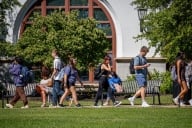You have /5 articles left.
Sign up for a free account or log in.
Most people who had a virtual birthday party or did virtual dating in the last year can attest that some things just weren’t the same during the pandemic. That was true in higher education -- and often for many of the same reasons. The eye contact and handshakes that are a regular part of teaching and learning in a face-to-face classroom were lost, which made the climb to the summit more challenging for many students. As a consequence of those losses, we may have even suppressed one of the most exciting and energizing parts of learning -- the entry into “flow state.” In the wake of this crisis, we may be able to give those lost benefits back to our students -- and in a variety of ways that foster learning.
To be clear, I am a strong advocate for the flexibility and accessibility of online education; I do not believe that higher education should be limited to the face-to-face environment. Indeed, research has shown that many people we serve with online education often wouldn’t have access to education at all if they couldn’t take advantage of the benefits that online education offers. Still, we are learning a great deal about what we and our students missed in this often-remote COVID year, along with hints of how we might do things differently.
Loss of Learning in Online
A remarkable 52 percent of students surveyed by Inside Higher Ed and College Pulse, with support from Kaplan, say that they learned less in academic year (AY) 2020-21 than they did in the pre-COVID years. If students learned less -- which we will be able to better assess this coming year as they move forward academically -- we must attempt to understand what that means for all of our curricula and what factors negatively (and positively) impacted their learning.
Compounding this, the disruption of both high school and college education during the spring when the pandemic began left only 6 percent of first-year students describing themselves as “very prepared” for AY 2020-21. The unexpected move to online, alongside the loss of face-to-face and hands-on experiences, may have left them feeling underprepared.
Complicating this issue is the fact that students who were online last year likely did not choose that environment; they were forced into it by the pandemic. Ninety-six percent of all students in the survey, most of whom had actively chosen face-to-face environments as their learning modality, were in a fully or partially online environment. That disruption may have made both the academic and the emotional components related to it harder for students who hadn’t planned on or chosen that flexibility, like those in a traditional online program. These students actually lost the face-to-face experience for which they had hoped.
Role of Interpersonal Contact
Perhaps related to the loss of that interpersonal contact (an interesting area for additional research), some of the struggle with learning in AY 2020-21 may be attributable to the higher levels of depression we saw in the traditional college-aged population during this time.
In the Student Voice survey, top concerns about performing well academically in the coming year were “difficulty concentrating” (58 percent) and “feeling unmotivated” (65 percent) -- both of which can be markers of depression. Half of students noted “mental health concerns” as a worry. Students fear that the stressors that plagued them this past year will follow them into the next and continue to impact them.
Flow State
A component of the struggle that we have not captured in most of our studies of this challenging period may grant us keener insight into why face-to-face environments have some advantages. Indeed, what struck me the most forcefully in the Student Voice research was the fact that over 80 percent of students surveyed said that concentrating during remote lectures was “extremely” or “somewhat” difficult. In addition, nearly half of the students surveyed said that their work took more time than it had in the past.
Student Voice explores higher education from the perspective of students, providing unique insights on their attitudes and opinions. Kaplan provides funding and insights to support Inside Higher Ed’s coverage of student polling data from College Pulse. Inside Higher Ed maintains editorial independence and full discretion over its coverage.
I read this as, in part, being about a loss of flow state. Flow state, which was called an “ideal state of work performance” in the April 2021 issue of the journal IEEJ Transactions on Electrical & Electronic Engineering, is generated by meaningful challenge and can be accelerated by group energy. We can experience it solo, often in the wake of productive engagement with others, and in well-functioning groups. Unplanned/unchosen isolation can lead to depression, frustration and loss of motivation. In turn, the loss of engagement -- eye contact, handshakes and dialogue, all of which are fundamental features of the community in a college classroom -- may have also undermined the acceleration of learning that occurs as we foster and experience flow state.
Research during this disrupted academic year showed that “during online learning, feelings of disconnection, social isolation, distractions, boredom and lack of control exert a detrimental effect on the ability to reach the state of flow, the feeling of presence, the feeling of social involvement,” according to an April 2021 Behavioral Sciences article. The authors argue that, in a fully online environment, strong feelings of presence, engagement of the body and mind, can be created with tools like virtual reality.
Benefits of Technology
This is a valuable lesson, not just for a crisis, but as we teach our students across multiple learning modalities in the years to come. We can also use hybrid models of education delivery to foster in-person connection alongside the remote. Discerning new ways to create connection and community will help us help our students increase their academic success.
It’s not just about adding in more interpersonal contact. Over 30 percent of respondents to the Student Voice survey found chat boards, reminders/nudges and online discussions valuable adjutants to other kinds of support.
Strikingly, Hispanic and Latino students rated the value of interventions such as these a full 10 percentage points higher than other students. The Postsecondary National Policy Institute notes that 61 percent of Latinx students are first-generation college students, which suggests that they are already transcending other hurdles, like all first-generation students. This data suggests that these interventions, technologically or face-to-face, may make a real difference for our Latinx students and perhaps other demographics of students.
While it is unclear how much the absence of face-to-face engagement contributed to the challenges students experienced this year, we know that it was at least correlated. Given the array of concerns students identify in this study, we must strive to learn what we can about what was lost in this year, so we can better support student success in the future, not just understand their struggles in the past. We must create new models of both interpersonal and electronic support structures that attend to the needs of our students and help them be successful, whether we are in a crisis situation or not.










